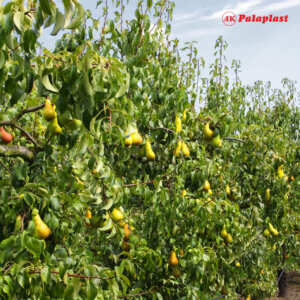
Pear Trees: Cultivation, Varieties, Benefits and Irrigation
The pear tree (scientific name Pyrus communis L.), Rosaceae family, Rosales genus, is a deciduous fruit tree of small to large size (depending on the rootstock used) with an upright branching arrangement and is a popular crop in all temperate regions.
Pear tree has its origin from the countries around the Caspian Sea and has been cultivated in Asia since ancient times. There is a reference in texts by Theophrastus about pear cultivation in ancient Greece from the 3rd century BC, while it was widely spread in Europe after the Roman Empire.
Pear tree belongs to the species resistant to very low temperatures (it can withstand temperatures as low as -20⁰C in the pre-flowering stage), but once the fruits set, its resistance is significantly reduced and drops to only -2⁰C, making pears with young formed fruits particularly vulnerable to spring frosts. Pear tree, compared to its relative apple, has lower requirements for cold winter temperatures to interrupt bud and seed dormancy, but is more tolerant of high summer temperatures (30-35⁰C).
Some of the most common varieties (local and non-local) that we find in Greece are:
- Krystalli or Tsakoniki, cultivated mainly in Macedonia and the Northern Peloponnese, bright green color and light redness of the peel in the rays of sun, tasty and very aromatic.
- Kontoula, cultivated in the western Peloponnese and characterized by excellent quality pears, very tasty and aromatic but also very sensitive to diseases.
- Passe Crassane, originating from Japan, large fruit size, aromatic, with a long shelf life and late ripening in early October.
- Abate Fetel, French variety with a large, thin-skinned, greenish-yellow fruit. It ripens at the beginning of September and preserves really well.
- Williams, the most widely grown pear variety in the world, as it has a very good shelf life. It has thin-skinned, medium-sized fruits with buttery flesh and a sweet taste.


Pear is an excellent choice of fruit for a number of reasons, including its low calorie content, only 58 calories per 100gr. It has high vitamin C content and is rich in flavonoids such as beta-carotene, lutein etc. Pear is a good source of minerals and B vitamins such as riboflavin and pyridoxine. Additionally pears can have a considerable benefit in improving LDL cholesterol levels due to their high fiber content.
The largest pear producing countries according to FAOSTAT are China (producing 7% of world production), USA (3.4%), Argentina (3%), Italy (2.8%), Turkey (2%), followed by countries with smaller production. Greece contributes 0.3% of world production.
IRRIGATION OF PEAR TREES
Pear trees are a water demanding cultivation, with particular needs at different stages of growth. They benefit from irrigation during their rapid vegetative growth, while water sufficiency late in the growing season indirectly affects the growth of vegetation in the following growing season. Lack of water at the fruiting stage leads to reduced total percentage of fruit production. Moreover water supply during the growing season has a positive effect on the growth of pear fruit size, especially in the period from May to August. Finally, watering pear orchards during the period from July to August increases the sugar content of fruits and improves their color and quality during preservation.
Palaplast has a wide range of products that can be used to install a reliable and efficient drip irrigation system for pear orchards:
- Irrigation pipes AGROPAL HDPE 80 και LDPE
- Pressure Compensating Driplines, Driplines (Paladrip – Palaplast, Paladrip-XL – Palaplast, Paladrip-Slim – Palaplast)
- Dripline fittings
- Drippers (Self Compensating Drippers – Adjustable Drippers – On Line Drippers)
- Clamp saddles, Punches, Micro-fittings
- Filters


